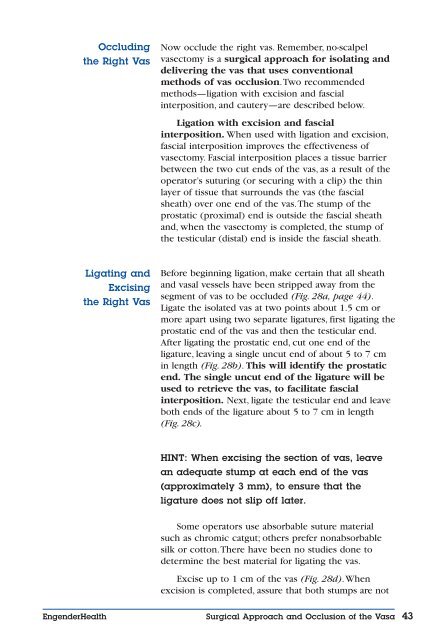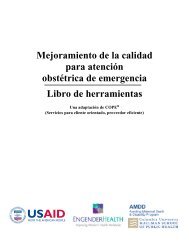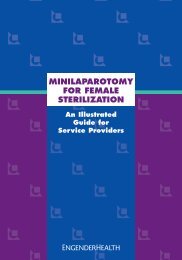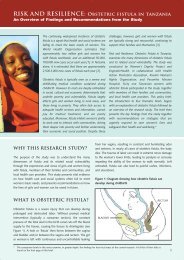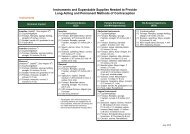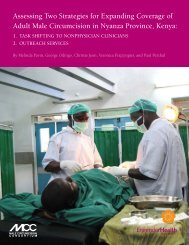No-Scalpel Vasectomy: An Illustrated Guide for ... - EngenderHealth
No-Scalpel Vasectomy: An Illustrated Guide for ... - EngenderHealth
No-Scalpel Vasectomy: An Illustrated Guide for ... - EngenderHealth
You also want an ePaper? Increase the reach of your titles
YUMPU automatically turns print PDFs into web optimized ePapers that Google loves.
Occludingthe Right Vas<strong>No</strong>w occlude the right vas. Remember, no-scalpelvasectomy is a surgical approach <strong>for</strong> isolating anddelivering the vas that uses conventionalmethods of vas occlusion.Two recommendedmethods—ligation with excision and fascialinterposition, and cautery—are described below.Ligation with excision and fascialinterposition. When used with ligation and excision,fascial interposition improves the effectiveness ofvasectomy. Fascial interposition places a tissue barrierbetween the two cut ends of the vas, as a result of theoperator’s suturing (or securing with a clip) the thinlayer of tissue that surrounds the vas (the fascialsheath) over one end of the vas.The stump of theprostatic (proximal) end is outside the fascial sheathand, when the vasectomy is completed, the stump ofthe testicular (distal) end is inside the fascial sheath.Ligating andExcisingthe Right VasBe<strong>for</strong>e beginning ligation, make certain that all sheathand vasal vessels have been stripped away from thesegment of vas to be occluded (Fig. 28a, page 44).Ligate the isolated vas at two points about 1.5 cm ormore apart using two separate ligatures, first ligating theprostatic end of the vas and then the testicular end.After ligating the prostatic end, cut one end of theligature, leaving a single uncut end of about 5 to 7 cmin length (Fig. 28b). This will identify the prostaticend. The single uncut end of the ligature will beused to retrieve the vas, to facilitate fascialinterposition. Next, ligate the testicular end and leaveboth ends of the ligature about 5 to 7 cm in length(Fig. 28c).HINT: When excising the section of vas, leavean adequate stump at each end of the vas(approximately 3 mm), to ensure that theligature does not slip off later.Some operators use absorbable suture materialsuch as chromic catgut; others prefer nonabsorbablesilk or cotton.There have been no studies done todetermine the best material <strong>for</strong> ligating the vas.Excise up to 1 cm of the vas (Fig. 28d).Whenexcision is completed, assure that both stumps are not<strong>EngenderHealth</strong> Surgical Approach and Occlusion of the Vasa 43


